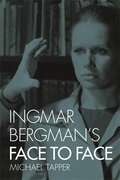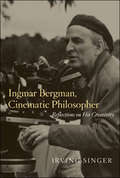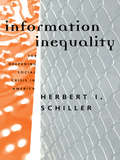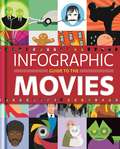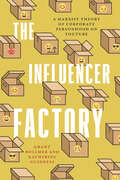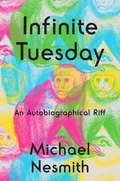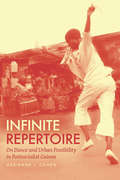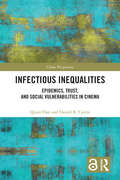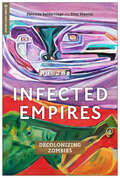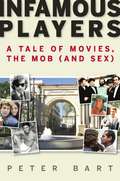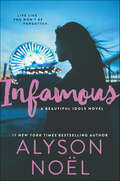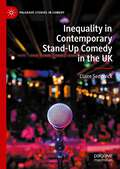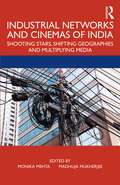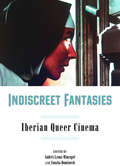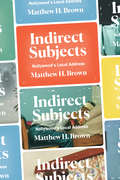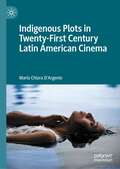- Table View
- List View
Ingmar & Liv's Love Letters
by Lázaro Droznes Agasel LindawanThis dramatic fiction is an intimate, truthful look at the 42-year relationship between the legendary actress Liv Ullmann and the famous filmmaker Ingmar Bergman. The story of their bond is told through exchanged letters over the course of their lives, letters which their daughter ended up with. They filmed 12 movies together and shared their experiences in cinema, theatre, and writing. This work is an homage to two of the greatest artists of the 20th century, two marvelous beings, inseparable friends, and soulmates. Their relationship has been described by Bergman as a bond between two “painfully connected” individuals. It started as a spirited romance between a director and his actress, despite a 20-year age gap, and transformed into a beautiful friendship that lasted more than 40 years.
Ingmar Bergman's Face to Face (Treasury Of The Indic Sciences Ser.)
by Michael TapperThe 1976 premiere of Face to Face came at the height of director-screenwriter Ingmar Bergman's career. Prestigious awards and critical acclaim had made him into a leading name in European art cinema, yet today Face to Face is a largely overlooked and dismissed work.This book tells the story of its rise and fall. It presents a new portrait of Bergman as a political artist exploring a new medium with huge public impact: television. Inspired by Henrik Ibsen, feminism, and alternative psychotherapy, he made a series of portraits of the modern bourgeois family focusing on the plight of women; Face to Face followed in the tracks of The Lie (1970) and Scenes from a Marriage (1973). By his workbooks, engagement planners, and other archival material, we can trace his investigation into the heart of repressive family structures to eventually glimpse a way out. This volume culminates in an extensive study of the two-year process from the first outlines of the screenplay to the reception and aftermath of Face to Face. It thus offers a unique insight into Bergman's world, his ideas and artistry during a turbulent time in cinema history.
Ingmar Bergman, Cinematic Philosopher: Reflections on His Creativity (The Irving Singer Library)
by Irving SingerThe development of themes, motifs, and techniques in Bergman's films, from the first intimations in the early work to the consummate resolutions in the final movies.Known for their repeating motifs and signature tropes, the films of Ingmar Bergman also contain extensive variation and development. In these reflections on Bergman's artistry and thought, Irving Singer discerns distinctive themes in Bergman's filmmaking, from first intimations in the early work to consummate resolutions in the later movies. Singer demonstrates that while Bergman's output is not philosophy on celluloid, it attains an expressive and purely aesthetic truthfulness that can be considered philosophical in a broader sense. Through analysis of both narrative and filmic effects, Singer probes Bergman's mythmaking and his reliance upon the magic inherent in his cinematic techniques. Singer traces throughout the evolution of Bergman's ideas about life and death, and about the possibility of happiness and interpersonal love. In the overtly self-referential films that he wrote or directed (The Best Intentions, Fanny and Alexander, Sunday's Children) as well as the less obviously autobiographical ones (including Wild Strawberries, The Seventh Seal, and the triad that begins with Through a Glass Darkly) Bergman investigates problems in his existence and frequently reverts to childhood memories. In such movies as Smiles of a Summer Night, Scenes from a Marriage, and Saraband, Bergman draws upon his mature experience and depicts the troubled relationships between men who are often weak and women who are made to suffer by the damaged men with whom they live. In Persona, Cries and Whispers, and other works, his experiments with the camera are uniquely masterful. Inspecting the panorama of Bergman's art, Singer shows how the endless search for human contact motivates the content of his films and reflects Bergman's profound perspective on the world.
Ingmar Bergman: New Edition
by Barry Keith Grant Robin Wood Richard LippeAt a time when few reviewers and critics were taking the study of film seriously, Robin Wood released a careful and thoroughly cinematic commentary on Ingmar Bergman's films that demonstrated the potential of film analysis in a nascent scholarly field. The original Ingmar Bergman influenced a generation of film scholars and cineastes after its publication in 1969 and remains one of the most important volumes on the director. This new edition of Ingmar Bergman, edited by film scholar Barry Keith Grant, contains all of Wood's original text plus four later pieces on the director by Wood that were intended for a new volume that was not completed before Wood's death in 2010. In analyzing a selection of Bergman's films, Wood makes a compelling case for the logic of the filmmaker's development while still respecting and indicating the distinctiveness of his individual films. Wood's emphasis on questions of value (What makes a work important? How does it address our lives?) informed his entire career and serve as the basis for many of these chapters. In the added material for this new edition, Wood considers three important films Bergman made after the book was first published-Cries and Whispers, Fanny and Alexander, and From the Life of the Marionettes-and also includes significant reassessment of Persona. These pieces provocatively suggest the more political directions Wood might have taken had he been able to produce Ingmar Bergman Revisited, as he had planned to do before his death. In its day, Ingmar Bergman was one of the most important volumes on the Swedish director published in English, and it remains compelling today despite the multitude of books to appear on the director since. Film scholars and fans of Bergman's work will enjoy this updated volume.
Inglourious Basterds: A Screenplay
by Quentin TarantinoFrom the most original and beloved screenwriter of his generation, the complete Oscar-nominated screenplay of Quentin Tarantino's World War II epic Inglorious Basterds. From the brilliant writer/director behind the iconic films Pulp Fiction, Kill Bill, and Once Upon a Time in Hollywood, comes Tarantino's most ambitious movie: a World War II epic starring Brad Pitt and filmed on location in Germany and France. The action tale follows the parallel story of a guerrilla-like squad of American soldiers called "The Basterds" and the French Jewish teenage girl Shosanna who find themselves behind enemy Nazi lines during the German occupation. When the Inglourious Basterds encounter Shosanna at a propaganda screening at the movie house she runs, they conspire to launch an unexpected plot to end the war. Pitt plays Lieutenant Aldo Raine -- the leader of the Basterds. Raine is an illiterate hillbilly from the mountains of Tennessee who puts together a team of eight Jewish-American soldiers to hunt down the Nazis. Filled with Tarantino's trademark electric dialogue and thrilling action sequences, Inglourious Basterds is one of the most celebrated films of the twenty-first century.
Information Inequality
by Herbert SchillerHerbert Schiller, long one of America's leading critics of the communications industry, here offers a salvo in the battle over information. In Information Inequality he explains how privatization and the corporate economy directly affect our most highly prized democratic institutions: schools and libraries, media, and political culture. A master media-watcher, Schiller presents a crisp and far-reaching indictment of the "data deprivation" corporate interests are inflicting on the social fabric.
Infographic Guide To The Movies (Infographic Guides)
by Karen Krizanovich"Naturally, there are all the types of information you'd expect to find in a book like this... but there's a whole lot more than that on offer here." - Starburst Magazine100 stunning, ingenious and absorbing movie infographics!Infographic Guide to Movies presents unique, witty and surprising facts about every film genre, from blockbuster, rom-com, horror, crime, sci-fi and action, to noir, zombie, nouvelle vague, slasher, erotica, world cinema and much, much more. Mixing cinematic fact with legend, it features infamous and often ludicrous tales of Hollywood, Bollywood, European cinema, underground and indie filmmaking.More than just a book of words, with graphs, Venn diagrams and charts, this book provides a unique overview of the movie world, boasting over 100 original artworks and illustrations and at-a-glance facts to amaze and astound readers-such as whether movies with a naked Helen Mirren or a naked Zach Galifiankis are likely to be more successful in Albania. There are graphics on every major movie genre and market in the world.Discover...Where in the world you're most likely to come across zombies.What the ultimate leading man would look like.Which actor was the best Bond.Who would win a fight between Rocky and Rambo.Judd Apatow's secret formula. How to kill Bruce Willis.How to get from Thomas Hardy to Tom Hardy.How much rom in a com makes the perfect rom-com. And so much more!
The Influencer Factory: A Marxist Theory of Corporate Personhood on YouTube
by Grant Bollmer Katherine GuinnessInfluencers are more than social media personalities who attract attention for brands, argue Grant Bollmer and Katherine Guinness. They are figures of a new transformation in capitalism, in which the logic of the self is indistinguishable from the logic of the corporation. Influencers are emblematic of what Bollmer and Guinness call the "Corpocene": a moment in capitalism in which individuals achieve the status of living, breathing, talking corporations. Behind the veneer of leisure and indulgence, most influencers are laboring daily, usually for pittance wages, to manufacture a commodity called "the self"—a raw material for brands to use—with the dream of becoming corporations in human form by owning and investing in the products they sell. Refuting the theory that digital labor and economies are immaterial, Bollmer and Guinness search influencer content for evidence of the material infrastructure of capitalism. Each chapter looks to what literally appears in the backgrounds of videos and images: the houses, cars, warehouses, and spaces of the market that point back to the manufacturing and circulation of consumer goods. Demonstrating the material reality of producing the self as a commodity, The Influencer Factory makes a crucial contribution to our understanding of contemporary economic life.
Infinite Wonder: An Astronaut's Photographs from a Year in Space
by Scott KellyFrom the record-breaking astronaut, national hero, and best-selling author of Endurance, a breathtaking collection of photos documenting his journey on the International Space Station, the vastness of space, and the unparalleled beauty of our own home planet.One's perspective shifts when one lives for an entire year--as Commander Scott Kelly, and no other American astronaut in history, has--in the isolating, grueling, and utterly unforgiving vacuum of space. Kelly's photos prove that this perspective--from 250 miles above Earth-- while hard-won, is also almost unspeakably beautiful. A gift for photography helped make Kelly a social media sensation, and here his photos are collected alongside his own commentary, which set the images in their proper contexts, human and cosmic. Kelly captures sunsets, moonrises, the aurora borealis, and the luminous, hazy tapestry of the Milky Way. He presents snapshots of life and work on the International Space Station, from spacewalks to selfies. But above all--or floating amidst all--he takes the earth itself as his celestial muse. Here are hurricanes, wrinkled mountains, New York City shining like a galaxy--glorious photographs that are, in themselves, a passionate argument for the preservation of our planet in the face of climate change and environmental destruction.
Infinite Tuesday: An Autobiographical Riff
by Michael NesmithMichael Nesmith’s eclectic, electric life spans his star-making role on The Monkees, his invention of the music video, and his critical contributions to movies, comedy, and the world of virtual reality. Above all, his is a seeker’s story, a pilgrimage in search of a set of principles to live by. That search took Nesmith from a childhood in Dallas, where his single mother Bette invented Liquid Paper, to the set of The Monkees in Los Angeles; to the heart of swinging London with John Lennon and Jimi Hendrix; and to an unexpected oasis of brilliance in the Santa Fe desert, where his friendships with Douglas Adams and Los Alamos scientists would point him toward the power of the infinite and the endless possibilities of human connection. This funny, thoughtful, self-aware book is a window onto an unexpected life, inflected at every turn by the surprising candor and absurdist humor of an American original. Opening Infinite Tuesday is like stepping into the world of Michael Nesmith, where something curious is always unfolding, and where riffs on everything from bands to dogs to the nature of reality make for an endlessly engaging journey.
Infinite Repertoire: On Dance and Urban Possibility in Postsocialist Guinea
by Adrienne J. CohenIn Guinea’s capital city of Conakry, dance is everywhere. Most neighborhoods boast at least one dance troupe, and members of those troupes animate the city’s major rites of passage and social events. In Infinite Repertoire, Adrienne Cohen shows how dance became such a prominent—even infrastructural—feature of city life in Guinea, and tells a surprising story of the rise of creative practice under a political regime known for its authoritarianism and violent excesses. Guinea’s socialist state, which was in power from 1958 to 1984, used staged African dance or “ballet” strategically as a political tool, in part by tapping into indigenous conceptualizations of artisans as powerful figures capable of transforming the social fabric through their manipulation of vital energy. Far from dying with the socialist revolution, Guinean ballet continued to thrive in Conakry after economic liberalization in the 1980s, with its connection to transformative power retrofitted for a market economy and a rapidly expanding city. Infinite Repertoire follows young dancers and percussionists in Conakry as they invest in the present—using their bodies to build a creative urban environment and to perform and redefine social norms and political subjectivities passed down from the socialist generation before them. Cohen’s inventive ethnography weaves the political with the aesthetic, placing dance at the center of a story about dramatic political change and youthful resourcefulness in one of the least-studied cities on the African continent.
Infinite Repertoire: On Dance and Urban Possibility in Postsocialist Guinea
by Adrienne J. CohenIn Guinea’s capital city of Conakry, dance is everywhere. Most neighborhoods boast at least one dance troupe, and members of those troupes animate the city’s major rites of passage and social events. In Infinite Repertoire, Adrienne Cohen shows how dance became such a prominent—even infrastructural—feature of city life in Guinea, and tells a surprising story of the rise of creative practice under a political regime known for its authoritarianism and violent excesses. Guinea’s socialist state, which was in power from 1958 to 1984, used staged African dance or “ballet” strategically as a political tool, in part by tapping into indigenous conceptualizations of artisans as powerful figures capable of transforming the social fabric through their manipulation of vital energy. Far from dying with the socialist revolution, Guinean ballet continued to thrive in Conakry after economic liberalization in the 1980s, with its connection to transformative power retrofitted for a market economy and a rapidly expanding city. Infinite Repertoire follows young dancers and percussionists in Conakry as they invest in the present—using their bodies to build a creative urban environment and to perform and redefine social norms and political subjectivities passed down from the socialist generation before them. Cohen’s inventive ethnography weaves the political with the aesthetic, placing dance at the center of a story about dramatic political change and youthful resourcefulness in one of the least-studied cities on the African continent.
Infinite Repertoire: On Dance and Urban Possibility in Postsocialist Guinea
by Adrienne J. CohenIn Guinea’s capital city of Conakry, dance is everywhere. Most neighborhoods boast at least one dance troupe, and members of those troupes animate the city’s major rites of passage and social events. In Infinite Repertoire, Adrienne Cohen shows how dance became such a prominent—even infrastructural—feature of city life in Guinea, and tells a surprising story of the rise of creative practice under a political regime known for its authoritarianism and violent excesses. Guinea’s socialist state, which was in power from 1958 to 1984, used staged African dance or “ballet” strategically as a political tool, in part by tapping into indigenous conceptualizations of artisans as powerful figures capable of transforming the social fabric through their manipulation of vital energy. Far from dying with the socialist revolution, Guinean ballet continued to thrive in Conakry after economic liberalization in the 1980s, with its connection to transformative power retrofitted for a market economy and a rapidly expanding city. Infinite Repertoire follows young dancers and percussionists in Conakry as they invest in the present—using their bodies to build a creative urban environment and to perform and redefine social norms and political subjectivities passed down from the socialist generation before them. Cohen’s inventive ethnography weaves the political with the aesthetic, placing dance at the center of a story about dramatic political change and youthful resourcefulness in one of the least-studied cities on the African continent.
Infectious Inequalities: Epidemics, Trust, and Social Vulnerabilities in Cinema
by Qijun Han Daniel R. CurtisThis book explores societal vulnerabilities highlighted within cinema and develops an interpretive framework for understanding the depiction of societal responses to epidemic disease outbreaks across cinematic history. Drawing on a large database of twentieth- and twenty-first-century films depicting epidemics, the study looks into issues including trust, distrust, and mistrust; different epidemic experiences down the lines of expertise, gender, and wealth; and the difficulties in visualizing the invisible pathogen on screen. The authors argue that epidemics have long been presented in cinema as forming a point of cohesion for the communities portrayed, as individuals and groups “from below” represented as characters in these films find solidarity in battling a common enemy of elite institutions and authority figures. Throughout the book, a central question is also posed: “cohesion for whom?”, which sheds light on the fortunes of those characters that are excluded from these expressions of collective solidarity. This book is a valuable reference for scholars and students of film studies and visual studies as well as academic and general readers interested in topics of films and history, and disease and society.
Infected Empires: Decolonizing Zombies (Global Media and Race)
by Patricia Saldarriaga Emy ManiniGiven the current moment--polarized populations, increasing climate fears, and decline of supranational institutions in favor of a rising tide of nationalisms-- it is easy to understand the proliferation of apocalyptic and dystopian elements in popular culture. Infected Empires examines one of the most popular figures in contemporary apocalyptic film: the zombie. This harbinger of apocalypse reveals bloody truths about the human condition, the wounds of history, and methods of contending with them. Infected Empires considers parallels in the zombie genre to historical and current events on different political, theological and philosophical levels, and proposes that the zombie can be read as a figure of decolonization and an allegory of resistance to oppressive structures that racialize, marginalize, disable, and dispose of bodies. Studying films from around the world, including Latin America, Asia, Africa, the US, and Europe, Infected Empires presents a vision of a global zombie that points toward a posthuman and feminist future.
Infamous Players
by Peter BartIn 1967, Peter Bart, then a young family man and rising reporter for the New York Times, decided to upend his life and enter into the dizzying world of motion pictures. Infamous Players is the story of Bart's whirlwind journey at Paramount, his role in its triumph and failures, and how a new kind of filmmaking emerged during that time. When Bart was lured to Paramount by his friend and fellow newcomer, the legendary Robert Evans, the studio languished, its slate riddled with movies that were out of touch with the dynamic sixties. By the time Bart had left Paramount in 1975, the studio had completed a remarkable run with such films as The Godfather, Rosemary's Baby, Harold and Maude, Love Story, Chinatown, Paper Moon, and True Grit. But this new golden era at Paramount was also fraught with chaos and company turmoil. Drugs, sex, runaway budgets, management infighting, and even the Mafia started finding their way onto the Paramount backlot, making it surely one of the worst-run studios in the history of the movie industry. As Peter reflects on the New Hollywood era at Paramount with behind-the-scenes details and insightful analysis, here too are his fascinating recollections of the icons from that era: Warren Beatty, Steve McQueen, Robert Redford, Clint Eastwood, Jack Nicholson, Marlon Brando, Al Pacino, Francis Ford Coppola, Roman Polanski, and Frank Sinatra among others. For over five decades, first on the inside as a studio executive, and later as the longtime editor-in-chief of Variety, Peter Bart has viewed Hollywood from an incomparable vantage point. The stories he tells and the lessons we learn from Infamous Players are essential for anyone who loves movies.
Infamous Players
by Peter BartIn 1967, Peter Bart, then a young reporter for theNew York Times, decided to upend his life and enter the dizzying world of motion pictures. Infamous Playersis the story of Bart’s remarkable journey at Paramount, his role in its triumphs and failures, and how a new kind of filmmaking emerged during that time. When Bart was lured to Paramount by his friend and fellow newcomer, the legendary Robert Evans, the studio languished, its slate riddled with movies that were out of touch with the dynamic ’60s. By the time Bart left Paramount, in 1975, the studio had completed an extraordinary run with such films asThe Godfather,Rosemary’s Baby,Harold and Maude,Love Story,Chinatown,Paper Moon, andTrue Grit. But this new golden era at Paramount was also fraught with chaos and company turmoil. Drugs, sex, runaway budgets, management infighting, and even the Mafia started finding their way onto the Paramount back lot, making it surely one of the worst-run studios in the history of the movie industry. As Peter reflects on the New Hollywood era at Paramount with insider details and insightful analysis, here too are his fascinating recollections of the icons from that era: Warren Beatty, Steve McQueen, Robert Redford, Clint Eastwood, Jack Nicholson, Marlon Brando, Al Pacino, Francis Ford Coppola, Roman Polanski, and Frank Sinatra, among others. For over five decades, Peter Bart has viewed Hollywood from an incomparable vantage point. The stories he tells and the lessons we learn fromInfamous Players are essential for anyone who loves movies.
Infamous Players
by Peter BartIn 1967, Peter Bart, then a young family man and rising reporter for the New York Times, decided to upend his life and enter into the dizzying world of motion pictures. Infamous Players is the story of Bart's whirlwind journey at Paramount, his role in its triumph and failures, and how a new kind of filmmaking emerged during that time.When Bart was lured to Paramount by his friend and fellow newcomer, the legendary Robert Evans, the studio languished, its slate riddled with movies that were out of touch with the dynamic sixties. By the time Bart had left Paramount in 1975, the studio had completed a remarkable run with such films as The Godfather, Rosemary's Baby, Harold and Maude, Love Story, Chinatown, Paper Moon, and True Grit. But this new golden era at Paramount was also fraught with chaos and company turmoil. Drugs, sex, runaway budgets, management infighting, and even the Mafia started finding their way onto the Paramount backlot, making it surely one of the worst-run studios in the history of the movie industry.As Peter reflects on the New Hollywood era at Paramount with behind-the-scenes details and insightful analysis, here too are his fascinating recollections of the icons from that era: Warren Beatty, Steve McQueen, Robert Redford, Clint Eastwood, Jack Nicholson, Marlon Brando, Al Pacino, Francis Ford Coppola, Roman Polanski, and Frank Sinatra among others.For over five decades, first on the inside as a studio executive, and later as the longtime editor-in-chief of Variety, Peter Bart has viewed Hollywood from an incomparable vantage point. The stories he tells and the lessons we learn from Infamous Players are essential for anyone who loves movies.
Infamous (Beautiful Idols #3)
by Alyson NoelFans of One of Us Is Lying and Genuine Fraud will love this explosive and satisfying finale to the provocative and suspenseful Beautiful Idols series from #1 New York Times bestselling author Alyson Noël.Club promoters Layla, Aster, and Tommy never imagined that entering the Unrivaled competition would land them in the middle of a celebrity murder investigation, but sometimes fate can be as nasty as the anonymous comments on a Hollywood gossip blog. But Madison Brooks isn’t dead. Layla, Aster, and Tommy have been set up, and as Madison’s dirty little secrets creep closer to the light, they discover Madison will do anything to keep her past hidden—no matter who gets caught in the crossfire.
Inequality in Contemporary Stand-Up Comedy in the UK (Palgrave Studies in Comedy)
by Claire SedgwickThis Pivot explores the cultural economy of comedy in the UK, looking specifically at the links between industry practices and structures and who produces comedy in the UK. The research is based on interviews with comedians in the East Midlands; significantly, this demographic has been historically under-researched in studies of precarity, where the East Midlands is typically overlooked in discussions of arts funding and access in favour of a more simplistic north/south divide narrative. Similarly, whilst there has been increased discussion of the precarity of the creative and cultural industries, as well as media articles on the difficulty of breaking into comedy as a member of a marginalised group, there has been relatively little academic research to support this. While Friedman’s work in particular has been helpful for understanding the link between comedy producers, class and taste making, there has been less attention paid to the sociologies of work within comedy. This book fillsthese gaps in research by exploring the experiences of comedians in the East Midlands, contributing to the rich body of scholarship on inequality in the cultural industries and promoting a better understanding of the impact of structural inequalities and precarity on access to the cultural industries.
Industrial Networks and Cinemas of India: Shooting Stars, Shifting Geographies and Multiplying Media
by Monika Mehta Madhuja MukherjeeThis volume points to the limits of models such as regional, national, and transnational, and develops ‘network’ as a conceptual category to study cinemas of India. Through grounded and interdisciplinary research, it shows how film industries located in disparate territories have not functioned as isolated units and draws attention to the industrial traffic – of filmic material, actors, performers, authors, technicians, genres, styles, sounds, expertise, languages, and capital, across trans-regional contexts -- since the inception of cinema. It excavates histories of film production, distribution and exhibition, and their connections beyond regional and national boundaries, and between places, industrial practices, and multiple media. The chapters in this volume address a range of themes such as transgressive female figures; networks of authors and technicians; trans-regional production links and changing technologies, and new media geographies. By tracking manifold changes in the contexts of transforming media, and inter-connections between diverse industrial nodal points, this book expands the critical vocabulary in media and production studies and foregrounds new methods for examining cinema. A generative account of industrial networks, this volume will be useful for scholars and researchers of film studies, cinema studies, media studies, production studies, media sociology, gender studies, South Asian studies, and cultural studies.
The Individualist: Digressions, Dreams and Dissertations
by Todd RundgrenThe author, a multi-talented producer and musician with such hits as "Hello It's Me," "Can We Still Be Friends," "Earth Mother," and "Everybody" describes in one-page anecdotes his childhood and adult life. He discusses the struggle growing up with a neglectful father, his antics with his best friend, memories of childhood injuuries--all with summary conclusions and witty, and sometimes profound, philosophy.
Indiscreet Fantasies: Iberian Queer Cinema (Campos Ibéricos: Bucknell Studies in Iberian Literatures and Cultures)
by Ann Davies Meredith Lyn Jeffers Nina L Molinaro Ana Corbalán Jennifer Brady Darío Sánchez González Ibon Izurieta Joan Ramon Resina María Teresa Vera-Rojas William Viestenz Kelly Moore Rui Trindade OliveiraPedro Almódovar may have helped put queer Iberian cinema on the map, but there are also multitudes of other LGBTQ filmmakers from Catalonia, Portugal, Castile, Galicia, and the Basque Country who have made the Peninsula one of the world’s most vital sources for queer film. Together, they have produced a cinema whose expressions of queer desire have challenged the region’s conservative religious and family values, while intervening in vital debates about politics, history, and nation. <P><P> Iberian Queer Cinema is a unique collection that offers in-depth analyses of fifteen different films, each by a different director, produced in the region over the past fifty years, from Narciso Ibáñez Serrador’s La residencia (The House That Screamed, 1970) to João Pedro Rodrigues’ O ornitólogo (The Ornithologist, 2016). Together, they show how queer Iberian cinema has responded to historical traumas ranging from the AIDS crisis to the repressive and homophobic Franco regime. Yet they also explore how these films gesture towards a more fluid understanding of sexuality, gender, and national identity. This book will thus give readers a new appreciation for both the cultural diversity of Iberia and the richness of its moving and thought-provoking queer cinema. <P><P> Published by Bucknell University Press. Distributed worldwide by Rutgers University Press.
Indirect Subjects: Nollywood's Local Address
by Matthew H. BrownIn Indirect Subjects, Matthew H. Brown analyzes the content of the prolific Nigerian film industry's mostly direct-to-video movies alongside local practices of production and circulation to show how screen media play spatial roles in global power relations. Scrutinizing the deep structural and aesthetic relationship between Nollywood, as the industry is known, and Nigerian state television, Brown tracks how several Nollywood films, in ways similar to both state television programs and colonial cinema productions, invite local spectators to experience liberal capitalism not only as a form of exploitation but as a set of expectations about the future. This mode of address, which Brown refers to as “periliberalism,” sustains global power imbalances by locating viewers within liberalism but distancing them from its processes and benefits. Locating the wellspring of this hypocrisy in the British Empire's practice of indirect rule, Brown contends that culture industries like Nollywood can sustain capitalism by isolating ordinary African people, whose labor and consumption fuel it, from its exclusive privileges.
Indigenous Plots in Twenty-First Century Latin American Cinema
by Maria Chiara D'ArgenioIn this engaging book, Maria Chiara D’Argenio delineates a turn in recent Latin American filmmaking towards inter/cultural feature films made by non-Indigenous directors. Aimed at a global audience, but played by Indigenous actors, these films tell Indigenous stories in Indigenous languages. Over the last two decades, a growing number of Latin American films have screened the Indigenous experience by combining the local and the global in a way that has proved appealing at international film festivals. Locating the films in composite webs of past and present traditions and forms, Indigenous Plots in Twenty-First Century Latin American Cinema examines the critical reflection offered by recent inter/cultural films and the socio-cultural impact, if any, they might have had. Through the analysis of a selection of films produced between 2006 and 2019, the book gauges the extent to which non-Indigenous directors who set out to engage critically with colonial legacies and imaginaries, as well as with contemporary Indigenous marginalization, succeed in addressing these concerns by ‘unthinking’ and ‘undoing’ Western centrism and coloniality. Drawing on a wide range of disciplines and considering the entire cinematic process – from pre-production to the films’ production, circulation and critical reception – Indigenous Plots in Twenty-First Century Latin American Cinema makes the case for a holistic cultural criticism to explain the cultural and political work cinema does in specific historical contexts.

